Fiber Optic Installation: Key Challenges and Practical Solutions

Fiber optic technology is the cornerstone of modern telecommunications networks, delivering the high-speed, low-latency, and high-capacity connectivity that digital economies demand. As demand for broadband infrastructure accelerates in both developed and emerging markets, the pressure to expand fiber networks—quickly, efficiently, and sustainably—has never been greater. Yet despite the benefits of fiber, its deployment remains technically and operationally challenging. In this article, we take a closer look at the key issues hindering fiber optic installations and the most effective strategies for overcoming them, drawing from over a decade of field experience and industry best practices.
Physical and Environmental Barriers
One of the most consistent challenges in fiber installation is dealing with physical and environmental conditions. In dense urban areas, installers often face congested utility corridors, outdated or undocumented duct infrastructure, and space constraints in underground conduits. In contrast, rural and remote areas may lack basic infrastructure altogether, requiring greenfield deployment over long distances.
Rocky terrain, bodies of water, or protected natural areas may add further complexity. Even temporary environmental factors—such as rainfall, high humidity, or extreme temperatures—can impact trenching, cable laying, and splicing.
Strategic Solutions:
- Use microduct and microtrenching technologies to minimize disruption in urban zones.
- Employ aerial deployment where ground access is limited.
- Implement blown fiber systems for scalable and modular builds.
- Use GIS-based route mapping to plan around environmental risks and infrastructure constraints.
- Select ruggedized, weather-resistant cables rated for UV, temperature extremes, and moisture ingress.
High CAPEX and Skilled Labor Shortages
Deploying fiber infrastructure is capital intensive, especially in the early stages. Beyond civil works and materials, operators must invest in fusion splicers, OTDRs, inspection scopes, and high-precision connectors. Labor costs are further inflated by a lack of experienced technicians.
Strategic Solutions:
- Standardize deployment processes using prefabricated modules and closures.
- Opt for plug-and-play components to reduce splicing.
- Invest in technician certification programs to reduce operational errors.
- Consider outsourcing to experienced system integrators for critical build phases.
Over time, well-trained teams and standardization significantly reduce installation time and cost per connection.
Regulatory Complexity and Right-of-Way Access
Obtaining permits for excavation or pole attachment can take weeks or even months. Local municipalities, utility providers, and road authorities each impose different compliance requirements, leading to project delays.
Strategic Solutions:
- Build relationships with local authorities and utilities to streamline coordination.
- Prepare comprehensive documentation early, including route drawings, environmental assessments, and engineering designs.
- Where possible, deploy in existing public infrastructure pathways to avoid new permitting.
In several countries, operators are advocating for “dig once” policies to mandate multi-use conduits during civil works—a policy that can reduce time-to-market and public disruption.
Long-Term Maintenance and Upgrade Constraints
A common oversight during installation is neglecting the future maintenance or expansion needs of the network. Poor labeling, limited slack management, and tightly packed closures make troubleshooting labor-intensive and costly.
Strategic Solutions:
- Use scalable closures and subrack systems with modular slots.
- Label all cables, fibers, and splitters using industry-standard color codes.
- Leave accessible slack loops at key points to allow future repairs or network expansion.
Good documentation, regular audits, and digital asset tracking using barcodes or QR codes can further streamline long-term O&M.
Interoperability and Vendor Lock-In
The growing diversity of vendors and regional standards has created compatibility issues in multi-operator environments. Proprietary connectors, non-standard splice trays, and varying cable dimensions can hinder system integration.
Strategic Solutions:
- Prioritize components that meet international standards such as ITU-T G.652D (singlemode), IEC 61754 (connector interfaces), and ISO/IEC 11801 (structured cabling).
- Choose open-platform systems that allow flexibility in vendor selection.
- Require suppliers to demonstrate third-party interoperability testing.
Avoiding vendor lock-in not only protects against supply chain risks but also facilitates future technology transitions, such as upgrading from GPON to XGS-PON or introducing network slicing in converged networks.
Fiber deployment is not a one-size-fits-all process. Whether delivering FTTH in cities, rural broadband in underserved regions, or mission-critical backbones for 5G and IoT, each project requires tailored planning and execution. The key to success lies in understanding the unique challenges of the environment, investing in scalable and standardized technologies, and empowering skilled teams to carry out efficient, high-quality installations.
As telecom networks evolve, fiber remains the foundation for reliability, speed, and adaptability. And for organizations seeking to stay ahead in a data-driven world, mastering fiber installation isn’t just an engineering challenge—it’s a strategic imperative.
Stay informed about the latest trends and technical insights in fiber optics and telecom infrastructure. Follow Yelco on LinkedIn and visit our official website at www.yelco.tech.
Connect with us for industry expertise, customized solutions, and future-ready fiber deployment strategies.


